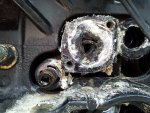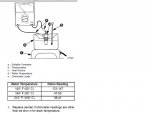I have a 1994 24' SeaRay with a 7.4L Bravo engine in it. I'll have to head to the marina tomorrow to get the serial number. I've owned the boat for about 5 years but have recently started doing the maintenance on my own. The temperature in my boat (per the gauge) has always run around 160-165 degrees F. The other day I was making a WOT run and felt like there was a loss of power for a second but I'm not sure. My eyes jumped to the temp gauge but it only read 170F. After reading online, I found out that my engine has a 140F thermostat in it. Is my temperature way too hot?
Since this episode, I changed the raw water pump impeller and housing, thermostat, water separating fuel filter, and temperature sending unit. I took the boat out today and it still ran around 165 degrees F and crept up to 170F as I backed off the throttle after a 3/4 throttle run. It doesn't seem to go above 170F. It seems to cool down to around 160F when getting up onto a plane at WOT then slowly works its way back up.
At this point I am wondering what direction to go or if anything is really wrong. My next thoughts would be to back flush the cooling system and check the exhaust risers/elbows as I have no idea if they are original or not. Any suggestions are appreciated.
Thanks,
Gabe
Since this episode, I changed the raw water pump impeller and housing, thermostat, water separating fuel filter, and temperature sending unit. I took the boat out today and it still ran around 165 degrees F and crept up to 170F as I backed off the throttle after a 3/4 throttle run. It doesn't seem to go above 170F. It seems to cool down to around 160F when getting up onto a plane at WOT then slowly works its way back up.
At this point I am wondering what direction to go or if anything is really wrong. My next thoughts would be to back flush the cooling system and check the exhaust risers/elbows as I have no idea if they are original or not. Any suggestions are appreciated.
Thanks,
Gabe





















